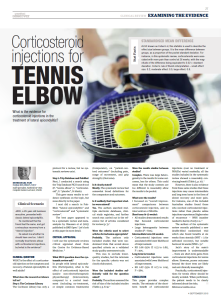This article was published in Medical Observer.
The article is also available on the Medical Observer website (may need registration).
Clinical scenario
Jack, a 45-year-old business executive presented with classic lateral epicondylitis. He mentioned that his friend had the same, and got a miraculous recovery from a “steroid injection”. He asked me whether he should have one too. I didn’t normally treat tennis elbow with corticosteroid injections but what is the evidence?
Clinical question
What is the effect of a corticosteroid injection on the symptoms and recovery of lateral epicondylitis in well adults?
What does the research evidence say?
Step 1: The Cochrane Library
The Cochrane Library has only a protocol for a review, but no systematic reviews exist.
Step 2: TripDatabase & PubMed
Next, I conducted a search using the TripDatabase PICO search tool (P: “tennis elbow”, I: “corticosteroid”, C: “placebo”, O: blank). This gave many results to evidence syntheses on the topic, but directly to the paper.
I next did a search in PubMed: “lateral epicondylitis” and “corticosteroid” and “systematic review”. The best paper appeared to be a systematic review and meta-analysis by Olaussen et al. (2013) published in BMJ Open. [1] Let’s look at this paper in more detail.
Critical appraisal
I will use the systematic reviews critical appraisal sheet from the Centre for Evidence Based Medicine. [2]
What PICO question does the systematic review ask?
In people with lateral epicondylitis (Participants); what is the effect of corticosteroid injection (and/or non-electrotherapeutic physiotherapy) (Intervention); compared to a control treatment (including no-treatment, or simple common treatments) (Comparator); on “patient-centred outcomes” (including pain, range of movement, and grip strength) (Outcome).
Is it clearly stated?
Mostly. The systematic review had somewhat broad definitions for the comparators and outcomes.
Is it unlikely that important studies were missed?
Yes. The authors searched multiple electronic databases, clinical study registries, and further search was carried out in the reference list of articles considered for review (p. 3). [1]
Were the criteria used to select articles for inclusion appropriate?
Probably. The authors only included studies that were randomised trials that scored above specified criteria on a validated study quality assessment scale. This was to exclude lower quality studies, but rationale for the specific criteria was not clearly elaborated.
Were the included studies sufficiently valid for the question asked?
Probably. The authors assessed the risk of bias of the included studies (Table 2, p. 8-9). [1]
Were the results similar between studies?
Complex. There was large heterogeneity in the results for some outcomes, and less for others. This could mean that the study contexts are too different to reasonably allow the results to be pooled.
What were the results?
I focussed on “overall improvement” comparisons between corticosteroid injection, and no intervention or NSAIDs.
Short term (4-12 weeks):
- all studies demonstrated results that favoured corticosteroid injections
- large heterogeneity between studies (I2 > 65%)
Intermediate term (26 weeks):
- corticosteroid injections were associated with lower likelihood of improvement
- RR 0.66 (95% CI 0.53 to 0.81), I2 = 35%
Long term (52 weeks):
- corticosteroid injections were associated with lower likelihood of improvement
- RR 0.87 (95% CI 0.73 to 1.04), I2 = 58%
Conclusion
This paper provides complex results. Even though the estimate of the short term benefit of corticosteroid injections (over no treatment or NSAIDs) varied markedly, all the studies included in the systematic review demonstrated a reasonably convincing benefit (Table 3, p. 10). [1]
However, there is also evidence from these same studies that these injections may cause intermediate and long term harm in the form of lower recovery, and more pain. For instance, one of the included studies by Australian investigators, found that those who received corticosteroid injections rather than placebo saline injections, experienced higher rates of recurrence – with an NNH (number needed to harm) of only 2.4. [3] The authors of the systematic review recently conducted and published a new double-blinded randomised trial, which also found benefits at 6 weeks from corticosteroids (NNT=3 for self-rated recovery), but notable harms at 26 weeks (NNH=5). [4]
Jack’s story of his mate’s improvement is quite understandable – there are short term gains from corticosteroid injections for tennis elbow. However, the poorer outcomes beyond the short term are likely real, and clinically meaningful. Pragmatically, corticosteroid injections for tennis elbow should be mostly avoided. When performed, the patient need to be clearly informed about the risks.
Stat Facts
Standardised mean difference
Also known as Cohen’s d, this statistic is used to describe the effect size between groups. It is the mean difference between groups, as a proportion of the pooled standard deviation. For instance, in this systematic review, corticosteroids were associated with more pain than control at 26 weeks, with the magnitude of the difference being equivalent to 0.32 × standard deviation. Cohen’s rule of thumb interpretation – small effect size: 0.2; moderate effect: 0.5; large effect: 0.8.
References
- Olaussen M, Holmedal O, Lindbaek M, Brage S, Solvang H. Treating lateral epicondylitis with corticosteroid injections or non-electrotherapeutical physiotherapy: a systematic review. BMJ Open 2013;3(10):e003564. DOI: 10.1136/bmjopen-2013-003564
- Systematic Review: Are the results of the review valid [MS Word document]? Centre for Evidence Based Medicine, University of Oxford. Last updated: 2008 Oct 1 (Retrieved: 2015 Aug 18) http://www.cebm.net/critical-appraisal/
- Coombes BK, Bisset L, Brooks P, Khan A, Vicenzino B. Effect of corticosteroid injection, physiotherapy, or both on clinical outcomes in patients with unilateral lateral epicondylalgia: a randomized controlled trial. JAMA 2013;309(5):461-9. DOI: 10.1001/jama.2013.129
- Olaussen M, Holmedal O, Mdala I, Brage S, Lindbaek M. Corticosteroid or placebo injection combined with deep transverse friction massage, Mills manipulation, stretching and eccentric exercise for acute lateral epicondylitis: a randomised, controlled trial. BMC Musculoskelet Disord 2015;16:122. DOI: 10.1186/s12891-015-0582-6

